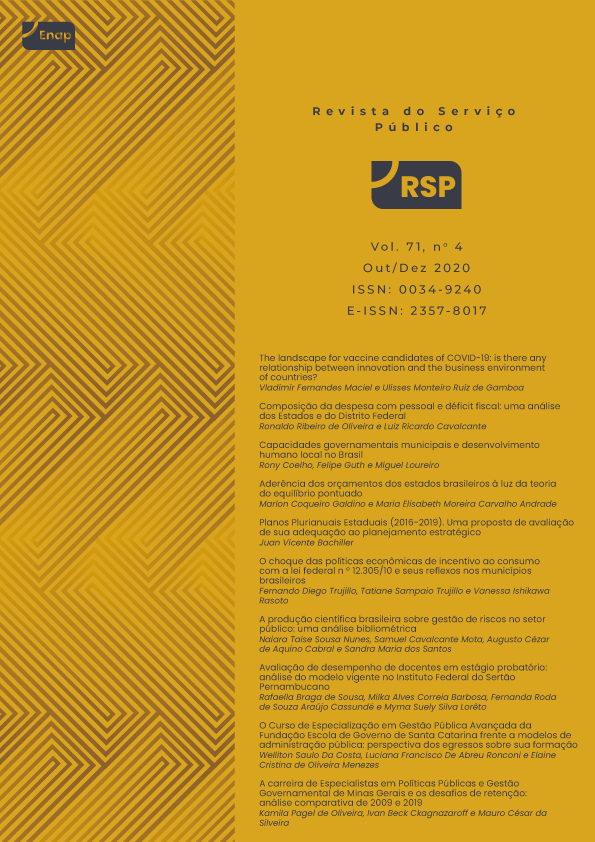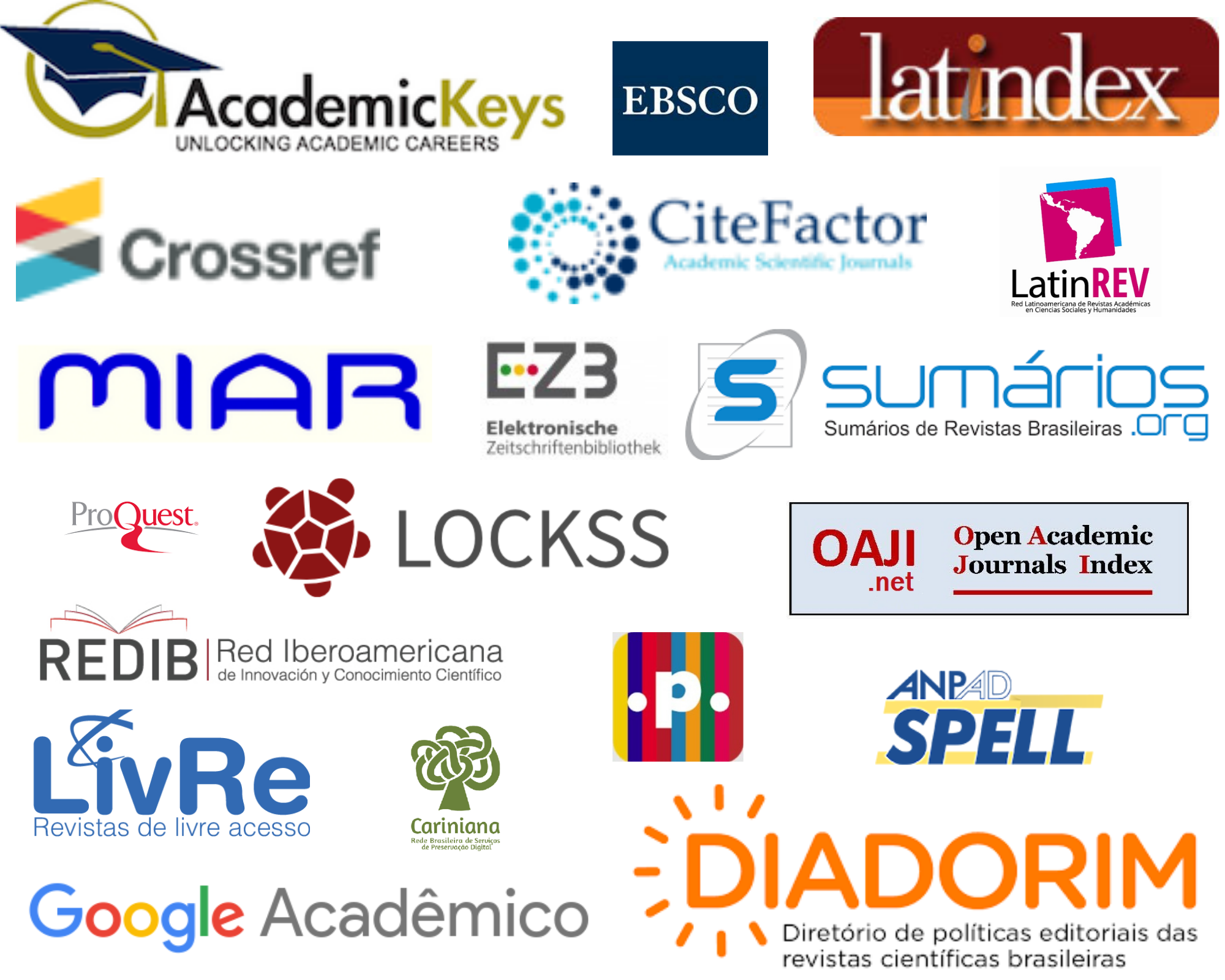The landscape for vaccine candidates of COVID-19
is there any relationship between innovation and the business environment of countries?
DOI:
https://doi.org/10.21874/rsp.v71i4.5066Palavras-chave:
COVID-19, vaccines, innovation, economic freedomResumo
The insurgency of the new coronavirus (SARS-COV-2) has attracted the attention of the public, authorities and academics. To date, no chemical treatment has proven efficient in clinical tests to combat the virus. The hope for the reopening of socioeconomic activities is found in the discovery of vaccines that can immunize people on a large scale. According to the World Health Organization, there are 29 vaccine candidates in the clinical evaluation phase and 138 candidates in the pre-clinical evaluation phase. In the race to discover a vaccine, there are initiatives from several laboratories and research centers. However, some countries stand out with a concentration of initiatives. This leads us to question whether this ability to promote research, development and seek innovation in the health field is not only associated with the size of economies, but also with the quality of the business environment. Thus, the aim of the present study is to explore the relationship between innovation and economic freedom, using econometric methodology (e.g. Panel Data Analysis) combined with non-parametric methodology (e.g., Data Envelopment Analysis). Our results allow us to infer how additional economic freedom can increase innovation for different levels of economic freedom within the countries. By doing so, we can explore why there is concentrated vaccine initiatives in few countries and a better understanding of the landscape for vaccine candidates of COVID-19.
Downloads
Referências
BANKER, R. D., CHARNES, A., & COOPER, W. W. Some models for estimating technical and scale inefficiencies in data envelopment analysis. Management science, 30(9), 1984, p.1078-1092.
BAYAR, Y. Impact of remittances on the economic growth in the transitional economies of the European Union. Economic Insights – Trends and Challenges, Volume 4(67), Issue 3, 2015, p.1-10.
BHAGWATI, J. Regionalism and multilateralism: an overview. Trading blocs: Alternative approaches to analyzing preferential trade agreements. Cambridge, MA: MIT Press, 1999, p.3-32.
BREITUNG, J.; MEYER, W. Testing for unit roots in panel data: Are wages on different bargaining levels cointegrated? Applied Economics, 26(4):353–361, 1994.
CHARNES, A.; COOPER, W. W.; RODES, E. Measuring the efficiency of decision-making units. European Journal of Operational Research, n. 2, 1987, p. 429-444.
CORNELL UNIVERSITY; INSEAD; WIPO. The Global Innovation Index. Fontainebleau, Ithaca, Geneva, 2016.
ERKAN, M. Economic freedom and innovation. International Journal of Science and Research, 4(7), 2015, p.1806-1809.
FARIA, F. P. Eficiência dos gastos municipais em saúde e educação: uma investigação através da análise envoltória no estado do Rio de Janeiro. Monografia premiada pelo Prêmio Ipea/Caixa Econômica Federal. Tema: Eficiência e Efetividade do Estado no Brasil, 2006.
GROEN, H. L., & VAN MEETEREN, N. L. The Value of Public–Private Partnerships in the Netherlands. Handbook of Biomarkers and Precision Medicine, 2019, p. 335.
IM, K. S.; PESARAN, M. H. & SHIN, Y. Testing for unit roots heterogeneous panels. Working Paper, Department of Applied Economics. University of Cambridge, 1997.
KAO, C. Spurious regression and residual-based tests for cointegration in panel data, Journal of Econometrics, 90, pages 1-44, 1999.
LEVIN, LIN & CHU. Unit root tests in panel data: asymptotic and finite-sample properties. Journal of Econometrics, volume 108, issue 1, pages 1–24, May, 1992.
LEVIN, LIN & CHU. Unit root tests in panel data: new results. Discussion Paper, pages 93 – 156, 1993.
MADDALA, G. S. AND WU, SHAOWEN. A comparative study of unit root tests with panel data and a new simple test. Oxford Bulletin of Economics and Statistics, 61(Special Issue):631–652, 1999.
McCOSKEY, S. & KAO, C. A residual-based tests for the null of cointegration in panel data, Econometric Reviews, 17, pages 57-84, 1998.
PEDRONI, P. Panel Cointegration: Asymptotic and finite sample properties of pooled time series tests with an Application to the PPP Hypothesis, Indiana University Working Papers in Economics, Nº. 95-013, 1995.
PEDRONI, P. Panel Cointegration: Asymptotic and finite sample properties of pooled time series tests with an Application to the PPP Hypothesis, new results, Indiana University Working Papers in Economics, 1997.
QIU, Y., CHEN, X., & SHI, W. Impacts of social and economic factors on the transmission of coronavirus disease 2019 (COVID-19) in China. Journal of Population Economics, 2020, p.1–46. Advance online publication.
QUAH, D. International patters of growht: persistence in cross-country disparities. Working Paper, MIT. 1990.
ROMER, P. Endogenous technological change. Journal of Political Economics, 98(5), Part 2: The Problem of Development: A Conference of the Institute for Study of Free Enterprise Systems, Oct., 1990, p.S71-S102.
SCHUMPETER, J. A. The Theory of Economic Development: An Inquiry into Profits, Capital, Credit, Interest, and the Business Cycle (Vol. 55). Piscataway, NJ: Transaction Publishers, 1934.
SALMELIN, B. The horizon 2020 framework and open innovation ecosystems. Journal of Innovation Management, 1(2), 2013, p.4-9.
SARNO, LUCIO & TAYLOR, MARK P. Real exchange rates under the recent float: Unequivocal evidence of mean reversion. Economics Letters, 60(2):131–137, 1998.
SJÖDIN HENRIK, WILDER-SMITH ANNELIES, OSMAN SARAH, FAROOQ ZIA, ROCKLÖV JOACIM. Only strict quarantine measures can curb the coronavirus disease (COVID-19) outbreak in Italy, 2020. Euro Surveil. 2020; 25(13), 2020, p.1-6.
SALMAN, A. K., ZAMPATTI, D., & SHUKUR, G. Macroeconomic Determinants, Innovation and the Birth of New Firms: Negative Binomial Regression Approach: Negative Binomial Regression Approach. International Journal of Economics and Finance, 5(11), 2013, p.72-81.
SOLOW, R. Technical change and the aggregate production function. Review of Economics and Statistics, 39, 1957, p.312–320.
THE HERITAGE FOUNDATION; THE WALL STREET JOURNAL. Index of Economic Freedom Promoting Economic Opportunity and Prosperity. Washington D.C., 2016.
WORLD HEALTH ORGANIZATION (WTO) Draft landscape of COVID-19 candidate vaccines. Publication. In: https://www.who.int/publications/m/item/draft-landscape-of-covid-19-candidate-vaccines. Access: August 15th, 2020.
Downloads
Publicado
Versões
- 2020-12-28 (2)
- 2020-12-24 (1)
Como Citar
Edição
Seção
Licença
Copyright (c) 2020 Revista do Serviço Público

Este trabalho está licenciado sob uma licença Creative Commons Attribution-NonCommercial-ShareAlike 4.0 International License.
- A RSP adota a licença Creative Commons (CC) do tipo Atribuição – Uso Não-Comercial (BY-NC).
- A licença permite que outros remixem, adaptem e criem obra licenciada, sendo proibido o uso com fins comerciais.
- As novas obras devem fazer referência ao autor nos créditos e não podem ser usadas com fins comerciais, porém não precisam ser licenciadas sob os mesmos termos dessa licença.
- Ao publicar o artigo na RSP, o autor cede e transfere para a ENAP os direitos autorais patrimoniais referentes ao artigo.
- O artigo publicado na RSP não poderá ser divulgado em outro meio sem a devida referência à publicação de origem.
- O autor que tiver o artigo publicado na RSP deverá assinar o Termo de Concessão de Direitos Autorais (em momento oportuno a editoria da Revista entrará em contato com o autor para assinatura do Termo).



